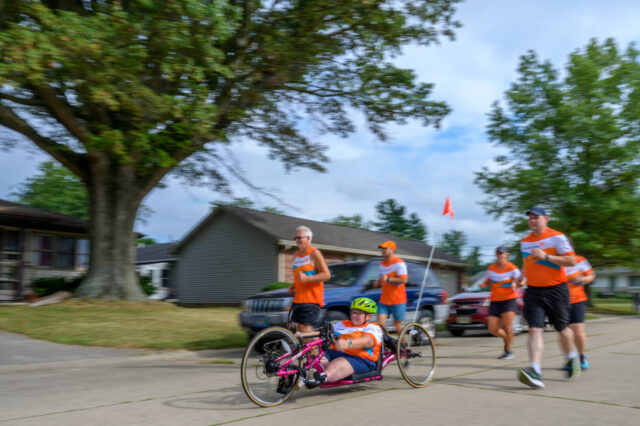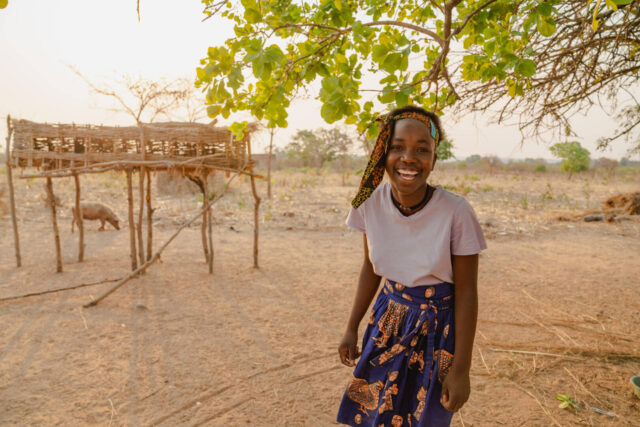In Kenya’s Northern Rift Valley, Sabina Riwo has gone to the river to get water nearly every day since she was 7. The twice-daily trip comes at a high cost for the 23-year-old mother of three. I stayed with Sabina for 24 hours, recording every moment of her day and noting the use of water and time. In doing so, I learned that in Kenya, water defines a woman.
3 p.m. — Meeting Sabina and her family
When I arrive at Sabina’s home in Chepkobegh, introductions are quick. Sabina is busy. It is lunchtime, and she has roasted maize over coals for her husband, Jacob, their three young daughters, and Philip, a nephew who lives with the family. As Sabina scuttles about the family’s perfectly swept, immaculately kept grounds, I peek into her water container. The plastic jug is almost empty, the bottom covered in sand.
I ask if she boils her water. “We know we should do it, but we don’t, she says. “With all the work to do, there is no time to boil it, so we just drink it the way it is.” Over the next 24 hours, I will see that’s true. But it’s a big chance to take — nine people in the area have recently died of cholera.
Jacob, 35, is a Pokot farmer who raises livestock. He drinks a cup of the dirty brown water and then another. The water jug is empty. It is time to get more.
Damaris, 5, the couples’ oldest girl, eyes me with interest. I ask if she knows about the United States. She tells me yes — the bags of food aid that come to this area are stamped “USA.”
3:50 p.m. — The walk for water
We leave to get water. Sabina stops at her friend Christina’s house to deposit her 7-month-old baby, Dorcas, with Christina’s 12-year-old daughter, Mary. It is too hard to carry both a baby and water on her back. We begin to walk through terrain that looks and feels like Arizona. The wind is hot. The ground is dry and thorny, but it sparkles with quartz and mica in the afternoon sun.
Our translator, Priscillah Lotukomoi, who has worked with World Vision for a decade, is also Pokot, and she helps me understand the context of the area. She calls a dried-up river “a cholera pond.” We pass another cholera pond on our walk to the river. It is surrounded by animal hoof prints, and only a few feet away are dishes and a water container.
4:45 p.m. — The water source
We reach the river. The quiet crunch of our feet over rocky ground is drowned out by new sounds — the rush of water and a cacophony of creatures as hundreds of cows, sheep, and goats mill about, mooing and bleating. Sabina and Christina first scrub their water jugs to get the dirt out. Then they scoop out a new hole near the river. It is important to dig a new hole; cows, goats, and sheep drink from the river throughout the day. There are goat droppings and cow pies everywhere. At night, gazelle, dik-dik antelope, and wild dogs come to get water.
Girls are washing in the river before they get water for their families. They bathe downstream, and the men bathe upstream. The girls bathe in groups. It’s safer this way.
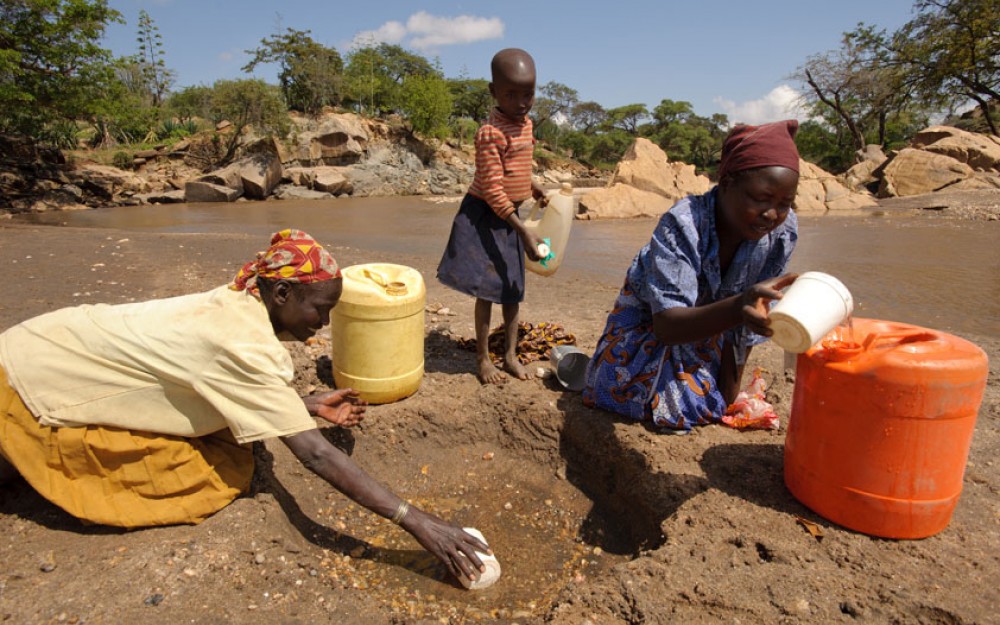
5 p.m. — Starting the trek home
After laborious minutes of scooping sand and pouring water into their jugs, the women are finished. Christina takes a long drink from the cup she’s used to fill her buckets. Sabina washes herself in the river, modestly pulling up her skirt to wash her feet and ankles. Then she loads the water jug on her back by lying down on a thin rope attached to the jug, strapping it to her shoulders, and standing up. Sabina weighs about 100 pounds. The water on her back weighs 70 pounds.
We head back to Sabina’s home, up the path of sparkling rocks and thorn bushes. Priscillah tells me that collecting water during the dry season is even more challenging. Community members may have to dig down as far as 30 feet to get water. Men climb into the hole and hand jugs up to the women. The waits are long. It can take seven hours to get water. Only one trip can be made instead of the usual two, so the women carry more buckets — doubling their load. “The dry season is a time of miscarriages,” says Priscillah.
About 20 minutes later, the women stop for a quick rest in the shade. Christina points out a tree from which she picked leaves last month to feed her family. Now the leaves are too hard to eat, she says. She surveys the earth. “Sometimes you can find rubies, and sometimes you can find gold,” she says. But Priscillah says that in Chepkobegh, rubies and gold do not make people rich. “They’ll trade a ruby for a bag of flour,” she says. “They’ll take 100 shillings [$1.25] for gold.”
6 p.m. — Arriving home
We arrive at Sabina’s home. Sabina takes her crying baby from Christina’s daughter, Mary. Dorcas nurses hungrily. Afterward, Sabina picks vegetables for cooking.
While she prepares the meal, I talk with Jacob. Sabina’s husband is a tall, handsome man with a smile that could sell toothpaste and the eyes of a dreamer. He says he has seven goats and seven kids, five sheep, and a chicken. He also has three cows, but last year’s drought forced him to move them to his sister’s home in North Pokot, near Uganda. It took three days to walk there, but he knew the cows wouldn’t have survived here.
While he talks, Sabina multi-tasks, boiling her dishware in the same hot water she will use to cook her vegetables — cowpeas and pumpkin leaves. She uses three cups to cook ugali, a dough-like porridge made from maize flour.
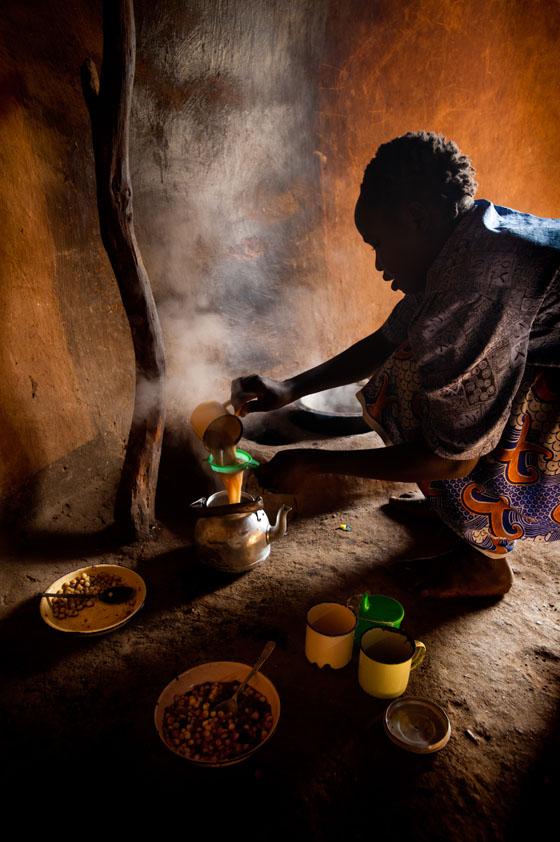
7 p.m. — Preparing the evening meal
Sabina is still cooking. There is no such thing as fast food in a Pokot woman’s life. She can’t microwave last night’s leftovers or call for pizza. Sabina washes the pumpkin leaves in one-and-a-half cups of water, singing to the baby to calm her crying. Then, setting the baby on a mat, she grabs an axe to chop more firewood. The sun has disappeared from the sky. With no electricity, it is dark but for the fire Jacob has made outside the hut.
7:50 p.m. — Time to eat
Sabina finally feeds her children the cooked vegetables and ugali. Jacob pours a cup of tea and tells me his story. As a boy, he loved school. But when he was in second grade, everything changed.
“There was a great famine. My father was dead,” he says. “My uncle said, ‘We must take the animals to Uganda.’” Jacob cared for the cows there for two years and came back to Kenya for third and fourth grades. But then another famine hit, and Jacob went back to Uganda until 1993. “I never went to school after that.”
School is a sensitive subject for Jacob. “I was first in the class. If it were not for the cows, I could have been somebody. My children must go to school.”
Sabina finishes sweeping the kitchen, washes the children’s plates, and then pours water from a tea kettle over Jacob’s outstretched hands so he can wash before he eats.
8:30 p.m. — Finally, rest
Sabina eats a quick dinner and takes the children into the sleeping hut. Jacob follows. Soon it is quiet. The silence makes me happy. Sabina is finally resting. I did not see her sit down all day.
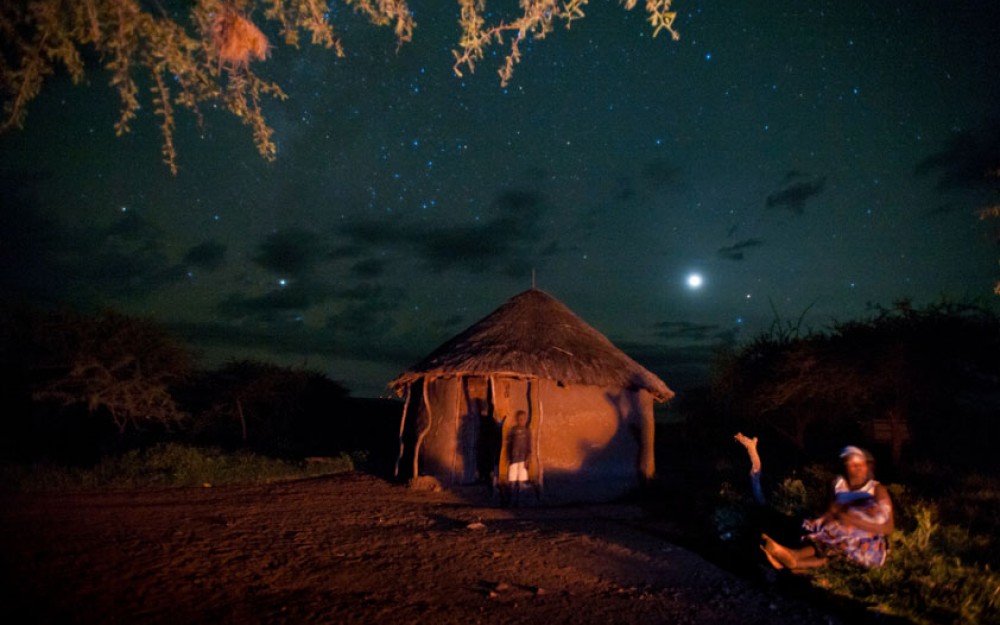
5:45 a.m. — The next morning
Sabina comes out of the hut and begins to sweep and sing, her only light from the stars above. She washes her hands and legs with the water that’s left. Then she starts boiling water for tea. At 6:30 a.m., the family begins to emerge from the hut. First is Damaris, who sits next to the smoky oven in the cooking hut, then Jacob. Sabina milks the goats right into the tin cups she’ll use to serve the family tea.
7 a.m. — Conserving water left from yesterday
The small water container is empty and there are only 13 pounds of water left in the 57-pound bucket. With practiced prudence, Sabina washes the four children, using the same bowl of soapy water to clean their clothes and scrub their little bodies. Then she feeds the children their breakfast, last night’s ugali mixed with tea and goat’s milk. Jacob goes off to the garden to brush his teeth with a stick.
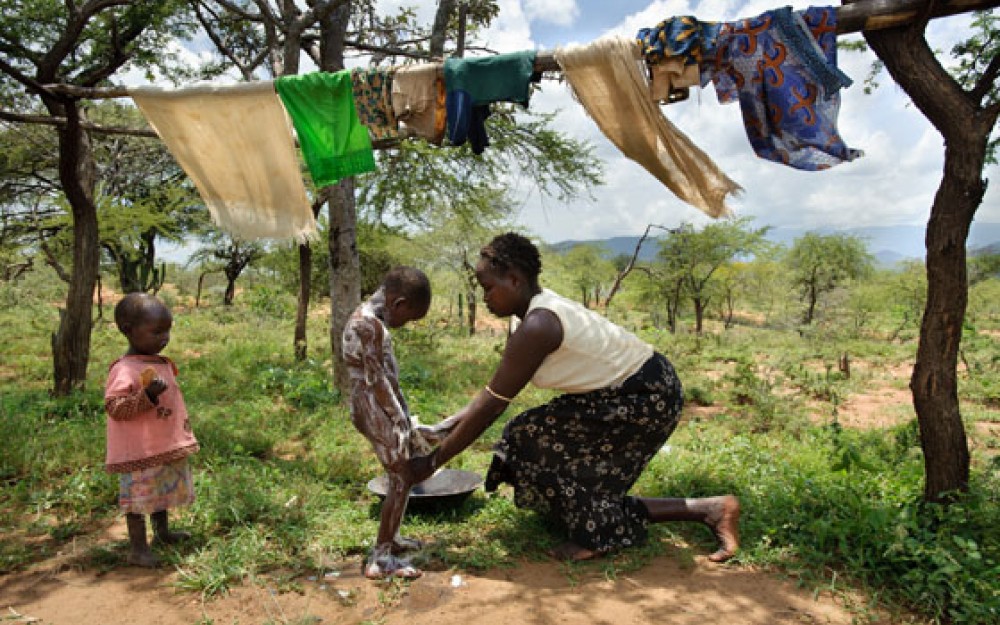
8 a.m. — Time to get more water
I check the water jug. It is empty. Sabina straps on her orange jug, grabs the smaller yellow jerry can, and departs to get water. Along the way, she tells me about her childhood. Getting water for her family is an early memory. “I also cared for the animals,” she says. “This [and getting water every day] denied me the chance to go to school.”
Lack of education still stings. “I have seen people who go to school do well and get jobs, and I feel bad that I could not go to school.”
In Pokot culture, getting water is a daughter’s responsibility. “I am the first daughter, so I had to assist the family in getting water,” Sabina says.
9:40 a.m. — Carrying 70 pounds of water
We begin the hour-long walk back home. I feel guilty not carrying any water. Every woman I’ve spoken to tells me how much it hurts. I know the only way I can comprehend the feeling will be to carry water myself, which I will do several days later. It is then that I will discover how painful it is, how the thin ropes cut into a woman’s shoulders, and how any slight incline on the path looms like Mt. Everest when you are carrying 70 pounds of water. I will have to scale a chest-high wooden gate that Sabina had to surmount through three pregnancies — including the days she gave birth. Come along on my trek in this video.
10:40 a.m. — Back to work at home
Arriving home, Sabina picks up the baby, and Winnie grabs her mother’s skirt, whimpering. The children miss her when she’s gone. She sits, for the first time that day, to breastfeed Dorcas. Then she hands the baby to Damaris and goes back to work, sharpening her machete. She walks off to gather firewood, returning a few minutes later with a load of wood strapped to her back.
Sabina’s stove needs to be rebuilt every time she uses it, using dirt from the garden. She packs the dirt around the sides of the stove; it will harden as the stove warms. Then she starts to cook and uses most of a small jerry can to clean the dishes.
12 p.m. — Completing daily chores
Sabina moves between washing clothes outside and the cooking hut, ensuring the ugali isn’t burning. After she dresses the girls, they play happily in the yard with a grasshopper.
Sabina sings, her voice high and strong as she moves to and fro: “If we follow the words in the Bible, we will receive eternal life.” Sabina is a song leader for her church, and she says singing strengthens her faith. “Faith gives me hope for the future and gives me encouragement to help my family,” she says.
Jacob arrives with the goats about 1:25 p.m., and Sabina gives them water. She feeds corn to the chicken, wringing off the kernels with a sharp twist. The goats try to eat the chicken’s corn and she shoos them away. Jacob watches and smiles.
2 p.m. — The walk for water leaves no time to rest
In the past 23 hours, Sabina has rested for only 12 minutes, except for when she was sleeping. Before she departs again to gather water, I ask her to sit so that we can talk.
She reveals a life-altering experience. Three years ago, she visited relatives in a place called Lelan, not far from Chepkobegh, which has a plentiful water supply. To Sabina, it felt like another world. People had water taps in their yards and could simply turn a handle to get water whenever they needed it. She walked from yard to yard, amazed. “I never knew there were places that weren’t like [here],” she says. “Once I was there, I didn’t want to come back.”
Sabina’s confession is remarkable for a woman so completely committed to her family. Seeing others with access to water made her start asking questions: Why was her life different and much more difficult than her relatives’ in Lelan? Our 24 hours together end with this question.
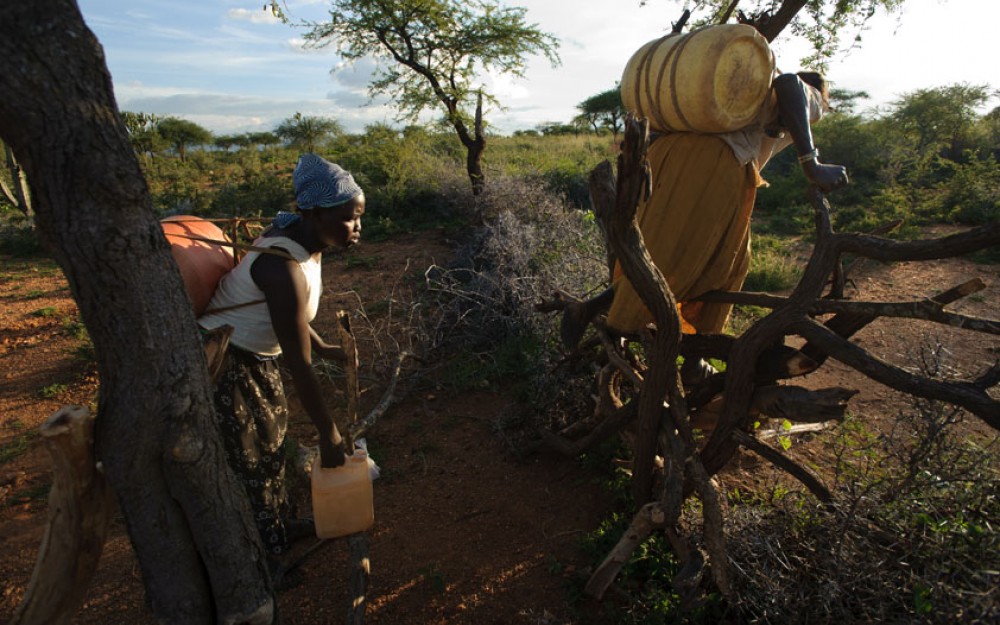
Sabina’s dream of clean water came true
Sabina’s story has a happy ending. Because of World Vision’s water projects in Kenya, her entire village of 100,000 people received water. And because she received water, she got her life back.
I saw Sabina this summer and she literally jumped for joy when we reunited. I jumped, too! “After we did the story, we saw a lot of changes,” she says. “I have now rested from going to the river. We are safe and clean. We have more animals. The women are so happy.”
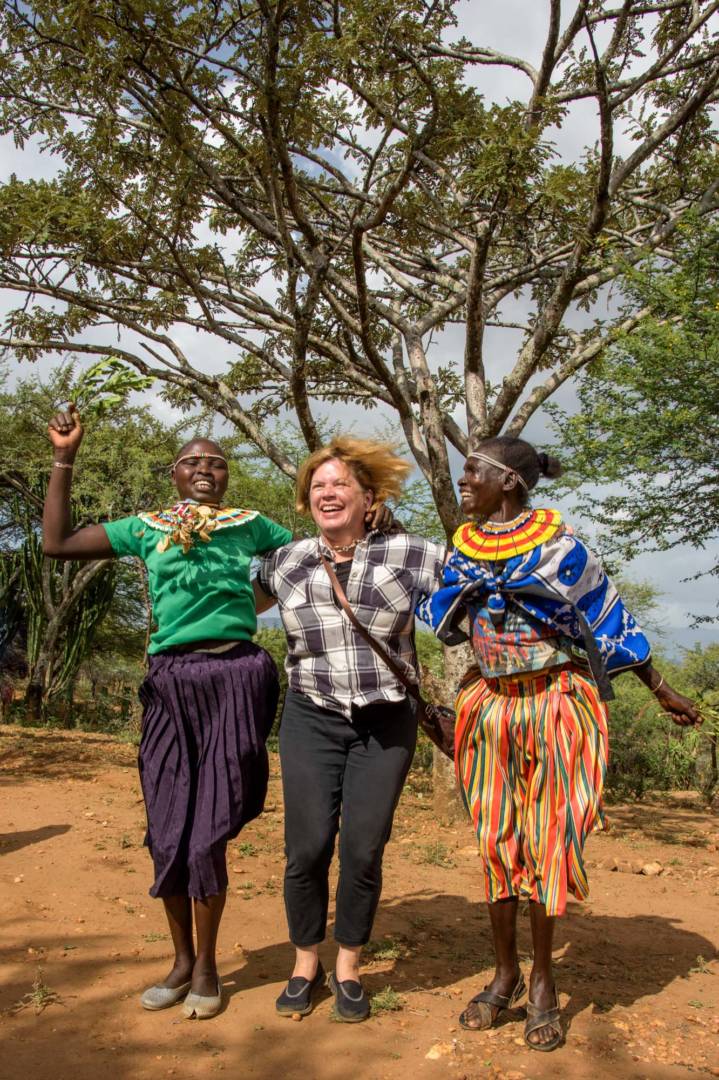
Sabina says her children no longer get sick. “Most of the waterborne diseases are gone,” she says. “The children go to school now.”
Water is benefiting the community, Jacob says. “The economy will improve. We face so much starvation, and water will help us grow crops to sell.” The community now grows far more vegetables using irrigation.
The community has also completely taken over the operation of the Muruny water project — its 51 miles of pipes and two tanks. “The project pumps more than 8,000 gallons a day,” says David King’oo, the brilliant World Vision engineer who developed the project. “Whatever we have done,” he says, “the glory goes to God.”
As for Sabina, she now owns a little restaurant, serving tea to her friends and neighbors. The restaurant is a short walk down the path from Sabina’s house. She uses clean water to make tea and wash dishes — clean water that flows from a tap right at her home. Another dream came true for Sabina — she now can bathe right at her home instead of at the dirty river.
My World Vision colleague, Angela Schug, witnessed a life transformed when she visited Sabina after water came to her village. And in the process, Angela was transformed as well.
I love Angela’s honesty in telling the story of Sabina and how she didn’t want to meet her, but how walking in Sabina’s shoes gave her a new perspective — just as it had done the same for me years before.
Water, women, and tradition
The time-consuming search for clean water has fed harmful traditional practices among the Pokot. Girls as young as 12 are forced into child marriage, in part for water-gathering duty. “Men wait for girls at water points,” says World Vision’s Priscillah Lotukomoi. “They pick them up and put them over their shoulders. They make them their wives.” The abducted girls leave their water containers by the riverside, and when their mothers find them, they know it’s too late — their daughters are gone.
World Vision has worked to stop the practice of forced marriage among the Pokot, establishing rescue centers for girls who manage to escape. Staff also addressed a related issue: female circumcision, also known as female genital mutilation (FGM) and cutting, which is done to prepare a girl for marriage.
Priscillah describes this Pokot tradition as a music-filled celebration that culminates with a painful, life-changing cut. “Many people come. It is done outside. Old women do it. There is no anesthesia. [The girl] is not supposed to show pain. If you cry, it brings shame to the family. Fathers come with spears. They spear the crying girls instead of letting them live with the shame of showing emotion.” Later, the procedure can cause complications during childbirth — already difficult for girls as young as 15.
In 1996, World Vision staff saw that girls were dropping out of school. “We asked communities why,” says Priscillah. “They said, ‘[The girls] have to get married. They have to be circumcised.’” World Vision brought in medical professionals to talk about the dangers of FGM and the benefits of education for girls.
In time, the girls were able to speak for themselves. “In 2003, we invited government leaders and the village chiefs to listen,” says Priscillah. “After that, the community, local leaders, and government officials led by the district commissioner said, ‘No more FGM.’”
World Vision also worked with the women who conducted the FGM ceremonies, convincing 15 to leave the practice. Now, women encourage teen girls to become role models by getting an education and serving their villages.
Not long ago, nearly every girl in this area of Kenya was circumcised. A 2008 evaluation showed a decline of 75%. “Now girls are in secondary school,” says Priscillah.
